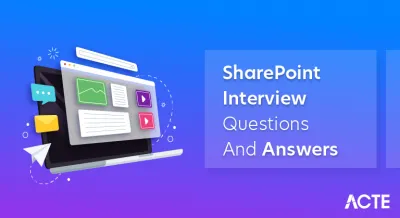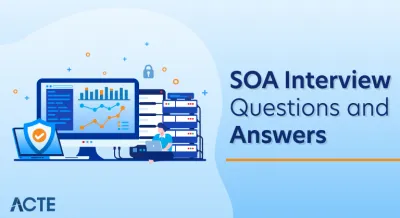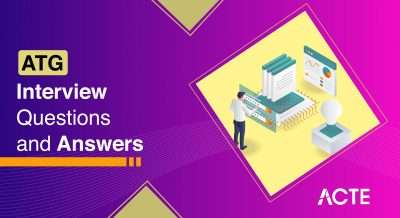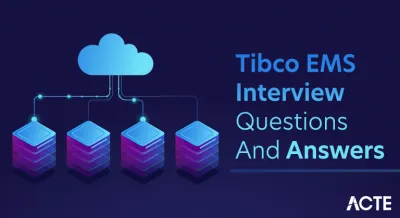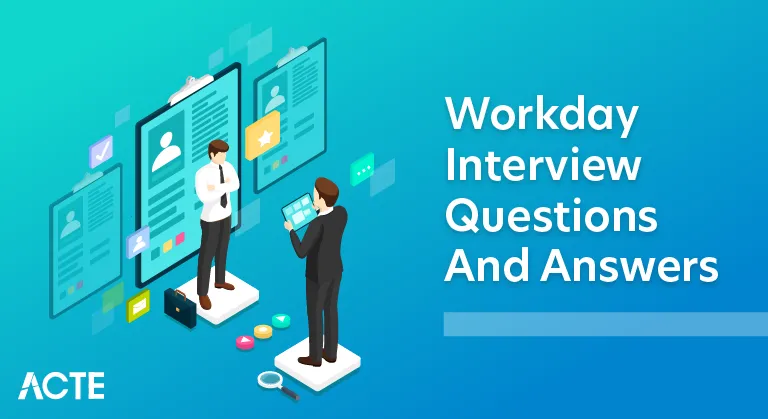
Workday is a cloud-based enterprise software platform offering Human Capital Management (HCM) and Financial Management solutions. It streamlines HR and finance operations, provides analytics and reporting tools, and emphasizes data security. Workday is a well-liked option for businesses of all sizes because of its scalability and user-friendly design.
1. What’s Workday?
Ans:
Workday is a pall- grounded software provider that specializes in fiscal operation and mortal capital operation results. Dave Duffield and Aneel Bhusri, two former directors at PeopleSoft, innovated it. When compared to HCM and other financial systems, it is a pioneer in SaaS business software and is renowned for its simplicity of use and lightning-fast setup.
2. What are the modules in the Workday?
Ans:
- Workday for Finance and Supply Chain
- Workday for HR and Payroll
- Workday’s Foundation Data Model
- Workday Reporting.
Following are the Workday modules:
3. What are the advantages of Workday?
Ans:
Workday benefits include:
Increased productivity: Functional retardation occurs when crucial operations are handled by distinct, unconnected systems.
More sapience into company data: Checks state that a single system gives lesser visibility into applicable data and better reporting.
Bettered functional effectiveness: Utmost businesses reported that functional effectiveness bettered when moved from multiple to a single system.
Reduced costs: Combining a number of crucial tasks may save money on technology, resources, and personnel time.
4. List out the main Workday features.
Ans:
- Performance operation
- Time tracking
- Recruiting and Onboarding
- Human Resource Management
- Audit and Internal controls
The main features of Workday are:
5. What companies use Workday?
Ans:
Workday is used by Walmart, Netflix, Adobe, Salesforce, VISA, Siemens, Santander, Prudential, COMCAST, Puma, and Ryan.
6. Why is Workday so popular?
Ans:
Workday provides a pall-native system with finance, HR, planning, and analysis. It enables you to operate more effectively than ever by allowing you to adapt to changes and surface perceptivity. With only one Workday HR solution, you can provide your business with genuine value. In addition, a lot of the biggest multinational organizations, like Netflix, Adobe, and others, rely on Workday to handle their HR and financial-related responsibilities.
7. Is Workday free?
Ans:
No, Workday doesn’t offer any free plan. To know further about Workday Pricing, communicate the deals platoon to get a quotation specifically acclimatized to your business conditions.
8. What database does Workday run on?
Ans:
Workday stores all metadata and operational data in a relational database. It stores all operation information and the most recent operation data in memory to improve operation speed.
9. How do I get access to the Workday?
Ans:
The Workday can be penetrated through the Workday App, OKTA App, or the website. First, you need to produce an account and use that credentials to pierce Workday in an association. As per the access rights given to the particular existent, you will get the availability of specific tasks and reports.
10. What kind of operation is Workday?
Ans:
Workday is a pall- grounded software seller specializing in enterprise resource operation, mortal capital operation, and fiscal operation operations.
11. What does a tenant mean in Workday?
Ans:
A tenant is an operation that requires its own secure computing terrain. Every workday client has their own secure tenant, which only they can pierce. Workday tenancy is a distinct instance of the program with its own set of data stored by Workday in a logically isolated database. Multi-tenancy is a key feature of Workday that allows you to see the whole evolution of Workday capabilities with a single action.
12. Will Workday run on any system and with any internet user?
Ans:
Yes, Workday is supported by nearly all internet cybersurfers, including Google Chrome, Internet Chrome, Firefox, and Safari.
13. Name a many post-production and pre-production Workday Tenants.
Ans:
- Sandbox Tenants
- Product Tenants
- Perpetration Tenant
- Gold Tenant.
Post-Production Workday Tenants:
Pre-Production Workday Tenants:
14. What kind of reports will Workday give?
Ans:
Workday’s HCM, financials, and payroll will offer standard and custom-made reports based on the needs of the organization. Many reports incorporate data from the Payroll/ HCM and Financial modules. These reports offer personalized prompts, computed fields, plates, maps, and interactivity. Data in the reports can be made available to other activities.
15. Is Workday an ERP system?
Ans:
Workday does really function as an ERP system. It is a comprehensive SaaS software platform for business information, planning, mortal capital operations, and finance. Enterprise-wide business operations and data transformation employ Workday ERP.
16. List down the Workday HCM modules.
Ans:
Workday HCM components include gift operation, time tracking, mortal resource operation, Recruiting and Onboarding, Workforce planning and analytics, Payroll Time and Absence operation inspection, and Internal Controls.
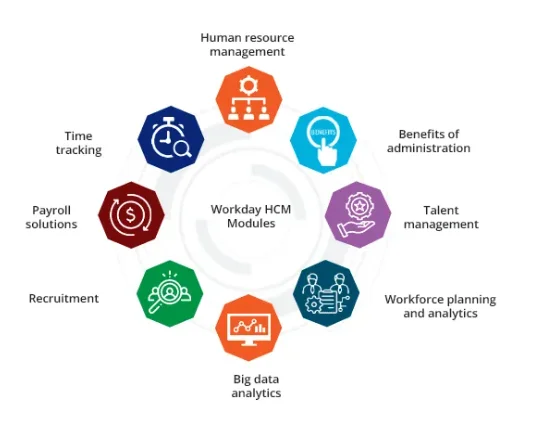
17. What are Workday Integrations?
Ans:
Workday presents a single armature, pall- grounded enterprise operations, and operation suites that blend HR, finance, and analytics into a single system. Through this, druggies can manage and customize data sets to any pool source fluently. Workday integrations are used for balancing high- security norms, important perceptivity, nimble updates, and intuitive UI across bias so that anyone can customize dashboards to get practicable perceptivity. Workday Integrations are classified into two types: Enterprise Information Builder (EIB) and Workday Studio Cloud Connect.
18. Name some security group types supported by Workday.
Ans:
Workday security groups fall into the following orders:
stoner- grounded, part- grounded, crossroad , Aggregation , Member- grounded.
19. What’s Workday Raas?
Ans:
RaaS stands for Reporting as a Service. Workday RaaS is a point that allows exporting data by creating a custom report within Workday and also exposes it as a web service. The affair can be of numerous formats similar as XML, RSS, or JSON and can be modified within the URI.
20. What do you understand about the term’ Business Process’ in Workday?
Ans:
In Workday, the business process is a collection of tasks that you can initiate, act upon, and finish to negotiate the asked business ideal as part of an HR procedure. Business processes define Workday’s core functionality. It describes how significant events inflow and allows the configuration of blessings, announcements, conditions,etc. Examples of business processes are changing jobs, Hiring, Terminating workers, Proposing Compensation Change, and more.
21. What type of conditions define Business Process Steps in Workday?
Ans:
StartProxy, one of the tasks in Workday, contains all the information about the organizational business operations. Business process methods include confirmation conditions, running conditions, admission conditions, and exit conditions.
22. Define Workday Business Process Framework.
Ans:
The Workday Business Process(WBP) Framework lets you to improve enterprise process flows by turning colorful conditions. It allows guests to configure and manage core overflows within the Workday to connect people, apps, and services. In the Workday operations, the business process frame is where all the sale- related changes to data and events appear.
23. Will business process events be impacted if you modify the business process description in Workday?
Ans:
In Workday, to edit the business process description, you need to search the business process name-> edit the description of the affiliated action. The already active business process won’t change as a result of writing a new business process definition. It continues to execute in the background without causing the event to get embedded.
24. Which task aids in the testing of the business procedure in the organization that is allocated to you?
Ans:
The work of “Process Validation” might help you test a business procedure assigned to you in an organisation. This activity contributes to ensuring that the stated procedures and systems are effective, efficient, and in accordance with the organization’s objectives, hence sustaining operational quality and consistency.
25. Which kind of blessings may be configured in a Business Process review step?
Ans:
In a Business Process review step, you can configure blessings related to approval, rejection, or conditional outcomes. These blessings determine the subsequent actions or routing of the process, allowing you to define the flow based on the review’s outcome.
26. How can Associations be tied to Business Processes?
Ans:
Workday allows you to configure Business Processes by enforcing a business process with multiple Organization-dependent delineations, Workday follows a scale to check which description to execute. An illustration could be multiple hire business process delineations depending on departments.
27. What report provides the details of all the conduct available for the specific Business Process Type?
Ans:
In the context of a Business Process management system, the report that offers data on all the conduct (or actions) accessible for a certain Business Process Type is sometimes referred to as a “Process Conduct Report” or a “Process Action Catalogue”. This report summarizes and defines all of the activities or behaviours that may be carried out inside a specific type of business process.
28. What’s a Business Process Completion Step?
Ans:
Once the completion phase has concluded the prosecution, the business process is said to be finished. All the conduct depend on business process completion but don’t depend on all the way being executed. For illustration, an association wants to hire a seeker, and that position requires background verification.
29. What conduct can you do with a Business Process Event if you want to modify its geste in a running state?
Ans:
You may change the geste pattern of the business process event by using conduct like cancel, reassign, correct, and delegate. Use the prefix “event” to search for events.
30. What are the types of reports generated by Workday?
Ans:
Introduction: Workday offers three main categories of reports. In this role, you will be able to summarize data on salary, time off, and other topics. Advanced: With this reporting type, you may manage complicated multi-data object reporting and perform complex record selection (filtering) and multi-level sorting. Compound: The Workday finance department uses this reporting type more frequently since it allows for more intricate calculations.
31. Give the prefix that is used to narrow the search for business processes.
Ans:
The prefix used to narrow the search for business processes is typically “BPF” or “BP_” (Business Process Filter). This prefix is commonly used in the context of business process management or automation systems to categorize and organize different processes. However, the specific prefix used can vary depending on the system or software being used.
32. Does IDS (Institutional Data Store) save all of the Workday and mainframe data?
Ans:
An Institutional Data Store (IDS) typically does not save all of the Workday and mainframe data. It is designed to store a subset of data from various institutional sources, which may include Workday and mainframe data, but only the data that is deemed necessary for reporting, analysis, and business intelligence purposes. The specific data stored in an IDS is determined by the institution’s needs and data governance policies. Storing all data would be impractical and unnecessary for most IDS implementations.
33. How do Workday’s business objects and data sources relate to one another?
Ans:
In Workday, business objects define specific data entities, and data sources determine how data from these objects is accessed and retrieved. Data sources provide the rules and structure for querying and extracting data from the related business objects, facilitating efficient data access and reporting.
34. Describe workday payroll.
Ans:
Workday Payroll is a cloud-based payroll software solution that helps organizations manage their payroll processes efficiently. It provides a unified platform for payroll administrators to handle various payroll-related tasks
35. Is Workday Payroll available as a stage-alone payroll service provider?
Ans:
No, Workday Payroll delivers full-service human resources management, including hiring, firing, payroll processing, and more. Workday HCM includes Workday Payroll as one of its parts.
36. Will Workday handle my payroll levies?
Ans:
You can choose either an intertwined service to manage payroll reporting and duty remittance or handle the entire duty process in- house, common in enterprise-position associations for better control of the processes.
37. Explain Workday Financial Management.
Ans:
Workday Financial Management is a pall result designed to give complete business sapience into your association. It captures all deals and supports core foundational processes in real- time. Workday Financial Management is erected on the adaptive, global foundation that delivers associations with core operation capabilities.
38. What’s Workday Studio?
Ans:
Workday Studio is an Integrated Eclipse-grounded terrain that allows Workday guests and 3rd parties to produce, emplace, remedy, and support complex integrations running in the Workday pall. It’s used to make ultramodern combinations that use colorful reports and Workday Web Service( WWS).
39. Explain Workday Human Capital Management.
Ans:
Workday mortal Capital Management( HCM) is a pall- grounded result that assists global businesses of all sizes in colorful assiduity verticals with pool planning and prosecution. Any changes that do with business circumstances and conditions, including worker assignments, reporting, business process rules,etc., are incontinently streamlined in the Workday HCM.
40. What are the types of reporting in Workday?
Ans:
Workday reports may be provided in two different ways: one is conventional, and the other is unique. Workday creates and oversees the management of standard reports. With the help of customized reports, company demands are met.
41. What are the ways to produce a report in Workday?
Ans:
- Run the produce Custom Report task.
- Copy a Workday Standard Report and modify it.
You can produce a report in two ways in Workday
42. Will anyone be suitable to see the same affair while running the report with the same input values?
Ans:
If a particular report is participated within the association. No, the affair will depend on the security access to the data source of the existent who’s running the report.
43. What are Calculated Fields?
Ans:
A advised field is used for data manipulation. It’s used in reporting, integrations, business processes, cataloging recreating processes, and other areas within Workday. You should run the produce Calculated Field task to produce calculated fields. Some of the essential effects you can perform with Calculated Fields are currency conversion, lookup-related values, string or textbook manipulation, evaluation of an expression, format a date,etc.
44. How Workday reporting is different from other SQL ERP systems?
Ans:
Workday follows an object-acquainted relationship model. While creating a report in Workday, you can elect a primary business object and a data source.
45. Name a many ways of how to pierce a Workday Standard Delivered Report?
Ans:
- Standard Delivered Report
- Browsing by Category in the Sitemap
- Writing the name of a specific report in the hunt bar
- Running Workday Standard Reports
The following are the ways to pierce Workday:
46. What are the two types of security programs in Workday?
Ans:
- Business Process programs
- Sphere Programs
47. How do you manage access to integrations?
Ans:
You need to produce an Integration System stoner and an Integration Security Group. Next, assign the Integration stoner to the Integration security group. also eventually, use that security group to add security policy access.
48. What’s the use of Domain Security programs?
Ans:
With sphere security programs, you can modify which group can view or modify particulars in a report/ task, or GET or PUT deals from an integration.
49. How do you manage access to integrations?
Ans:
In Workday, you can manage access to integrations through its security framework, which includes authentication, authorization, and role-based controls. Workday provides a robust set of tools for defining who can access, modify, or create integrations. To ensure data security and compliance within the platform, you may also utilise API keys or tokens for regulated access, and monitor access with logs and tracking systems.
50. What prefix do you use to search for integrations?
Ans:
In Workday, you typically use the prefix “WD:” (Workday prefix) to search for integrations. When you prefix your search queries with “WD:”, It enables the platform to recognise that you are seeking for particular Workday connections, making it simpler to find and use the appropriate tools and connectors.
51. List out some Integration ID types.
Ans:
- Worker Integration IDs
- Business Process Integration IDs
- Report Integration IDs
- Organization Integration IDs
- Position Integration IDs
52. What’s a WSDL?
Ans:
Web-based Service Description Language is used to specify how XML documents should be structured for input or to decide the affair of Workday Web Services.
53. Name the prefix that limits a hunt to reports?
Ans:
In Workday, the prefix that limits a search to reports is “RP:”. When you use “RP:” as a prefix in your search query, it specifies that you are looking for reports within the Workday system.
54. What are the advantages of using Workday?
Ans:
Workday presents organizations with a unified platform for HR and finance, which streamlines operations and offers real-time data accessibility. Its user-friendly interface enhances user adoption and productivity. With mobile access, the platform empowers employees to work from anywhere. Workday is scalable, can automate key processes, and maintains high-security standards.
55. Name some MVEL variables that you can use in Workday Studio?
Ans:
- “lp” to access launch parameters.
- “vars” to access MessageContextVariables.
- “props” to access message properties.
56. Explain some features of Workday HCM.
Ans:
Core HR Management: Centralized employee data and HR functions.
Employee Self-Service: Enables staff to handle their information.
Workforce Planning and Analytics: Data-driven decision support.
Time and Attendance: Tracks work hours for payroll and compliance.
Compensation Management: Manages salary, bonuses, and equity.
57. Which Workday Studio element translates a loop or a conditional if statement?
Ans:
In Workday Studio, you would use the “Decision” component to translate a conditional “if” statement. The “Decision” component allows you to create conditional logic to control the flow of a process or integration, similar to an “if-else” statement in programming. For implementing loops or iterating through a set of data, you would typically use the “Loop” component.
58. How does the talent management module of Workday help an organization?
Ans:
Efficient Recruitment: Simplifies the hiring process.
Performance Management: Facilitates reviews and goal setting.
Succession Planning: Identifies future leaders.
Learning and Development: Supports employee growth.
Career Planning: Helps with career paths.
59. What does ERP mean and how does ERP relate to Workday?
Ans:
In Workday Studio, you would use the “Decision” component to translate a conditional “if” statement. The “Decision” component allows you to create conditional logic to control the flow of a process or integration, similar to an “if-else” statement in programming. For implementing loops or iterating through a set of data, you would typically use the “Loop” component.
60. Can everyone generate reports using Workday?
Ans:
Not everyone can generate reports using Workday. Access to Workday reports gets determined by login credentials and settings. Every employee in the organization has some distinct level of access. The access level helps determine which reports or data the employee can view. If all employees have access to report reviewing, everyone in the organization can generate reports.’
61. Outline the difference between simple and advanced reports.
Ans:
Simple reports are different from advanced reports because employees cannot share simple reports but can share advanced reports. Also, simple reports are not RaaS enabled, whereas advanced reports are RaaS enabled. Both the reports provide in-depth knowledge and analytics about the human resources and finance department.
62. What are the different modules present in Workday?
Ans:
- Workday HCM
- Workday Financial
The different modules present in Workday are:
63. Does Workday support all internet browsers and computers?
Ans:
Workday is compatible with the majority of web browsers, including Google Chrome, Mozilla Firefox, and Safari. For individuals who must use earlier versions of Internet Explorer (e.g., Darcy or IRES users), you must log onto Workday using Chrome, Firefox, or Safari.
64. What sources of data will Workday employ moving forward for reporting?
Ans:
In addition to becoming the source of company information for HCM, payroll, and financials, Workday will, if possible, become the main source for your reporting needs. When data that are not currently available in Workday are required, Cognos or other tools will be utilized to complement Workday reporting capabilities.
65. Where will I get my reports if Workday goes live if I’m used to obtaining them through Cognos?
Ans:
When your organization transitions to Workday from a system like Cognos for reporting, you will typically get your reports through Workday’s reporting and analytics tools. Workday provides its own suite of reporting and analytics capabilities, which allow you to access and generate the reports you need. These tools are designed to work seamlessly with the data and processes within the Workday system.
66. Will the IDS contain all of the currently accessible mainframe and Workday data?
Ans:
No, the intrusion detection system is not a backup system. Any mainframe data that is no longer required will be archived separately. Workday data will be backed up on Workday servers. The Institutional Data save (IDS) will only save a subset of Workday data if it is designated as our most significant data and is required for a vital downstream report or data feed that Workday or another application cannot handle.
67. What degree of assistance does Workday HCM provide?
Ans:
- Online assistance
- Knowledge base
- Call assistance
Workday HCM provides the following support options:
68. What purpose does a diagnostic audit serve?
Ans:
A diagnostic audit aims to identify and analyze specific issues within an organization, pinpointing their root causes. It provides recommendations for improvement and supports data-driven decision-making while mitigating risks and aligning operations with strategic goals.
69. List the primary features of Workday Human Capital Management.
Ans:
- Management of Human Capital
- Timekeeping
- Payroll Services
- Administration of Objectives Management
- Governance of Succession
- Planning Your Profession and Growth
- Cloud-Based Payroll Co-Sourcing Solutions for Third-Party
70. How would you explain the Area Override Solution?
Ans:
When no other solution is able to supply such domains, area override solutions are used to add more fields, such as calculated fields, to the output.
71. What purpose does Workday cloud-connect serve?
Ans:
Workday Cloud Connect is an integration of a business suite that provides a centralized solution for managing employee benefits. The Workforce Cloud Connect solution assists businesses in developing, implementing, and managing a variety of benefit programs and prospects.
72. How is XSLT used in Workday?
Ans:
Workday transforms data using XSLT. When sophisticated logic requires the output of a series of discrete values, XSLT functions are utilized.
73. Is Workday an Enterprise Resource Planning system?
Ans:
Yes, Workday is an ERP solution in the real sense of the term. It is a centralized SaaS application for accounting, budgeting, human capital management, project execution, and business analytics. Workday ERP is utilized throughout the company to manage business operations and data transformation.
74. What is the purpose of a Workday provided report titled “Data Source”?
Ans:
This report is used to establish a connection between business objects, system services, and information sources.
75. What are the key distinctions between Workday’s ‘Business Process Framework’ and ‘Approval Framework’?
Ans:
| Aspect | Business Process Framework | Approval Framework | |
| Purpose |
Complex business processes |
Transaction approvals | |
| Workflow Complexity | Multi-step, complex | Straightforward approvals | |
| Configuration | Highly customizable | Standard approval paths | |
| Conditional Logic |
Extensive support |
Limited conditional logic |
76. Describe Workday’s security practices.
Ans:
Workday has two distinct types of security policies:
Workflow Policy: Specifies which network administrators have the ability to access and edit data inside domains.
Domain Policy: Specify all security groups that are permitted to engage in business processes.
77. What does the term “business process” mean?
Ans:
A business process is a series of activities that may be created, executed, and completed by customers. Such business processes are formed by the use of activities, authorization, and checklists.
78. What is the difference between a filter and a subfilter?
Ans:
The filter is used to select the main operating objects, while the Sub Filter is used to select the associated business unit.
79. What are the basic types of Workday HCM integrations?
Ans:
- Workday Studio
- Cloud Connectivity
- Enterprise Data Integrator
Workday integrations are classified into three broad categories:
80. Specify the RaaS report.
Ans:
In Workday, we may build custom reports and publish them as web applications. This may be accomplished through the use of the RaaS (Reporting as a Service) gateway. This web service would return data in RSS or JSON format.
81. What are the Workday business procedures?
Ans:
- Conditions of Admission
- State of Exit
- Limitations of Operation
- Criterion of Validation
- Workday Instruction
The procedures of Workday business are:
82. What distinguishes Workday reporting from that of other SQL-based enterprise resource planning systems?
Ans:
Workday Reporting is based on an object-oriented representation of relationships. While interpreting data, we must choose the significant business resource and database schema. SQL ERP systems employ a Relational Database Management System (RDBMS).
83. What are the major HCM product modules?
Ans:
- Administration of the workforce’s lifecycle
- Governance of organization
- Compensation administration
- Regulation of absences
- Incentives for employees
The major modules of workday HCM are as follows:
84. Describe the organizations in Workday.
Ans:
An organization is a collection of individuals who work together to accomplish a common goal. An organization is structured in such a way that a parent-child connection is possible. Supervisors at the top of the organizational structure will be able to monitor employees and approve business procedures.
85. Can we utilize Workday to track academic information about students?
Ans:
No, Everything relating to students, classes, schedules, and grades would be stored in the PeopleSoft Student Portal.
86. What information sources will Workday employ in the long term for reporting?
Ans:
Along with becoming the authoritative source of corporate data for human capital management, Workday would also serve as the primary repository of data for all reporting requirements wherever possible. Analysis out from IDS via Cognos or other technologies will augment Workday’s reporting and analysis.
87. Does IDS retain all records from the core and Workday?
Ans:
No, it would not retain all existing information. IDS, or Instructional Data Save, will only preserve Workday data that it deems critical for a backend report. And the information, which may be inaccessible to other apps.
88. What sorts of reports are available in Workday?
Ans:
Workday provides three distinct forms of reporting:
Basic: generate simplified reports about leaves, salary, and other areas on a regular basis and publish them as PDF or Excel.
Advanced: generate reports by connecting two tables, sorting rows, and summarizing on several levels.
Composite: generate reports that include more sophisticated computations.
89. What is time monitoring for workdays?
Ans:
Workday Time Tracking is a component of a broader system that includes absence management, human capital management, and compensation. By combining everything, you have a central repository of information and integrated actions that assist you in lowering labor expenses, improving efficiency, promoting employee well-being, and positively managing compliances.
90. What are the responsibilities of a Workday Human Capital Management consultant?
Ans:
The role of the human capital management consultant is to guarantee efficient distribution by designing and building, installing, and evaluating the human capital management system to suit the client’s unique requirements.
91. Who uses Workday HCM on a regular basis?
Ans:
Mid-sized enterprises and large businesses commonly utilize Workday HCM.
92. Define Workday HCM.
Ans:
Workday HCM (Human Capital Management) is a cloud-based application that consolidates several human resource activities such as task management, invoicing, and payroll, as well as talent acquisition, into a single system. Because Workday Software offers a broad set of services, many companies rely on it to meet their demands. Furthermore, it is simple to understand and execute.
93. Will every piece of existing data from the mainframe and Workday be available in the IDS?
Ans:
No, the IDS is not a backup system. Any data from the mainframe that will no longer be needed will be archived separately. Data that are in Workday will be backed up on Workday servers. The Institutional Data Store (IDS) will only store a subset of Workday data if the data have been identified as our most important data and are a requirement for a critical downstream report or data feed that cannot be handled by Workday or another application.
94. Explain the importance of data accuracy in Workday and how you ensure it.
Ans:
Data accuracy in Workday is crucial as it forms the basis for informed decision-making and compliance. Ensuring accuracy involves regular data validation, data quality checks, and defining clear data entry procedures. By maintaining accurate data, organizations enhance their HR and finance processes, promoting trust and integrity in their operations.
95. In Workday, what is the relationship between business objects and data sources?
Ans:
Workday saves data in the form of objects. A business object may be thought of as an entity’s blueprint, while a data source is the data subset or collection of data that forms the framework.
Workday defines and delivers data sources. A data source may be configured to deliver all replicas of the core business item or it can include Workday-defined filtering rules.


